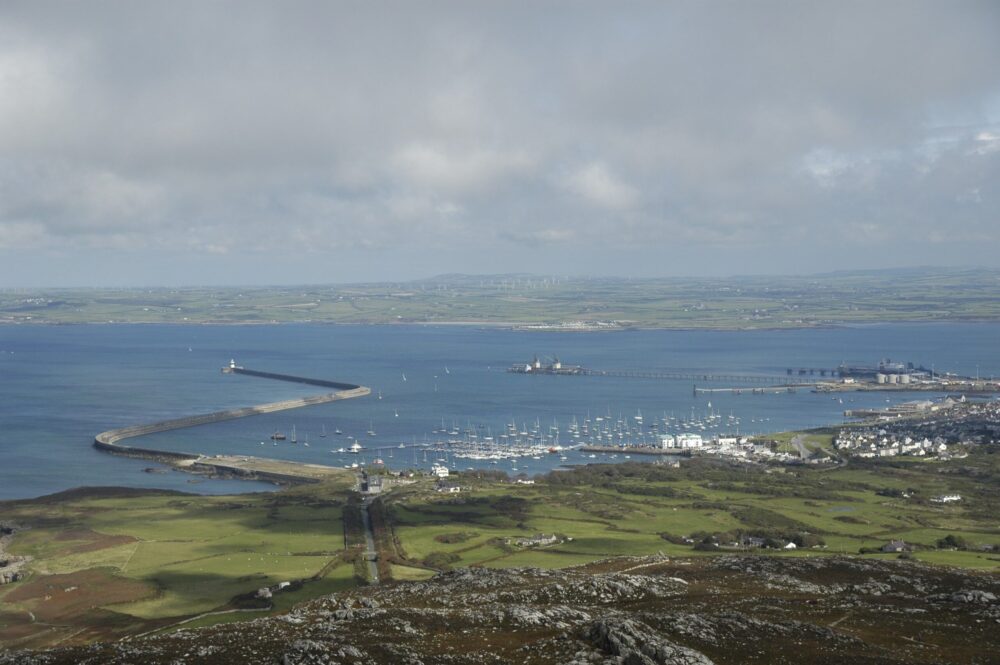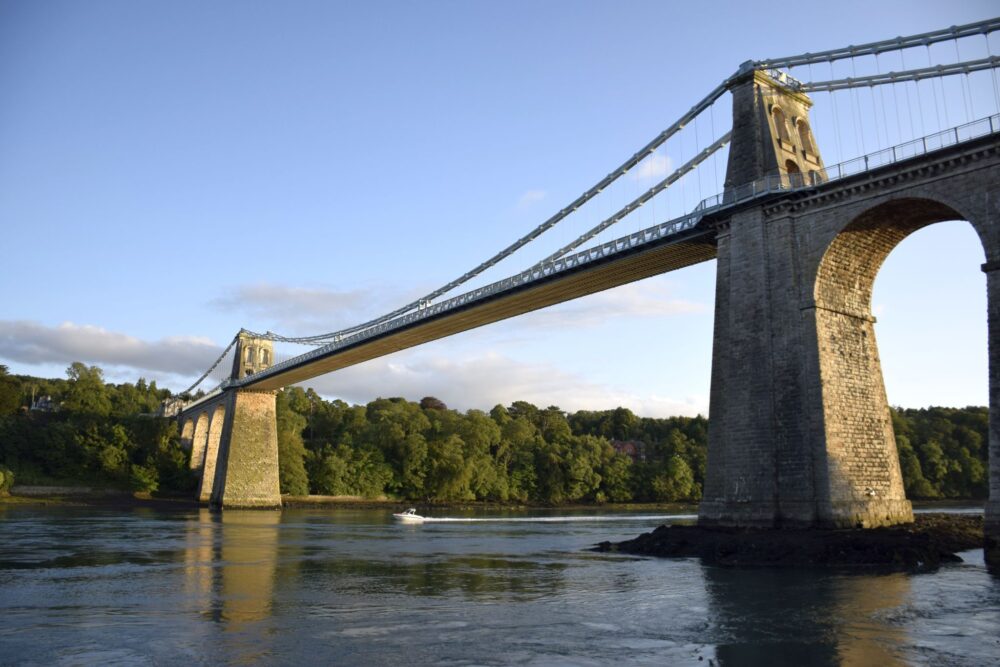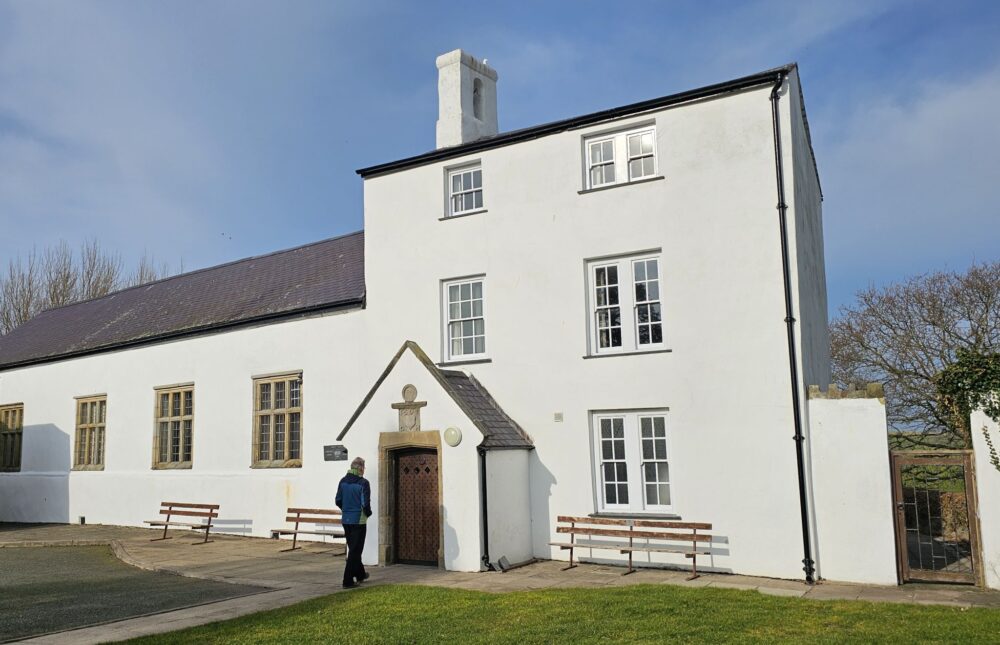Brendan’s voyage to Wales – personal reflections on connections between Anglesey and Ireland.

Catherine Duigan
Memories can become obscured over time by the mists of the Irish Sea. Are my childhood recollections of visits to Wales from Ireland real or imagined?
Being held in my father’s arms transfixed by the sight, sounds and smell of cattle slithering on to a boat destined for Holyhead. Did my parents know where they were going after the shocking scramble for the luggage and to get off the train when we reached The Junction? Followed by the delight of donkey rides, but fear of Mr. Punch, on Llandudno Beach.
Dublin born but Offaly reared, a lifelong relationship with Wales developed and decades later I find myself living on the other side of the Irish Sea – waiting at Holyhead. As a mass of diaries record and frustrated poetry reveals, there has been much waiting and contemplation done at Holyhead.
Storms and bad beer are unlikely generators of creativity.
Flat calm grey, the water and sky reflect each other. There is no horizon. The only ripples are being generated by a cold-water swimmer sliding into liquid space by the Maritime Museum.
Storm damage
After the storm damage to the port structures before Christmas, there is a fast turnover for the ferries in operation.
Black smoke pours from the Irish Ferries ship as it takes off for Ireland, passing the incoming Stena vessel near the tip of the massive breakwater.
I am waiting for my cousin Brendan, one of the delegates coming for the Anglesey Antiquarian Society (AAS) Day School exploring connections through time between Anglesey and Ireland.
Family networks and friendships have drawn others across the Irish Sea, including some from the Kilkenny Archaeological Society.
The following day, after a welcome by Lowri Ann Rees from Bangor University, Consul General of Ireland, Denise Mc Quade, referred to the huge concern in Ireland about the recent port closure. She is clearly delighted to be here to make contacts which will nurture the shared programme of interests between the Welsh and Irish Government across climate and sustainability, trade and tourism, education and research, language, culture and heritage and the diaspora.
Using evocative readings from his book, The Turning Tide – A Biography of the Irish Sea, Jon Gower painted a colourful canvas for us to sink into. From saints to Wally the Walrus, we were swept along in the eddies of migrating birds, secretive smugglers and revolutionaries, and the names of Irish trucking companies rolling off the ferry. We share a common love for nature, including the brent geese that winter in Dublin Bay and along the Anglesey coast.
Viking
Mark Redknap of Amgueddfa Cymru changed our perspective on the location of Anglesey.
Seen by a Viking, it is a central node on a navigational highway between Dublin and the Isle of Man. Placenames, like Anglesey, Bardsey, or the Great Orme, bear witness to the waves of diverse people making “Viking” a job description, not an ethnic term. The island was of strategic interest because it was a short sail from Dublin, with a multitude of landing points and great wealth in its monasteries. Delicate simple ring pins for holding cloaks and ornate chunky arm bracelets are archaeological examples of their Irish craftwork found on Anglesey.
A balloon, a coffin and a treaty provided the structure for the stories told by Paul O’Leary, author of the definitive history of the Irish in Wales. After a 5.5-hour sea crossing, the bumpy landing in July 1817 for balloonist William Sadler was analogous to the tangled relationship between Ireland and Anglesey after the Acts of Union.
The tragic need to repatriate bodies home to Ireland were either opportunities to honour the noble dead or politically interfere in the tragedy of painful loss. Shameful headlines were generated worldwide following the forceful seizure of Terence McSweeney’s coffin from his family at Holyhead. In contrast, liberated prisoners often reported the strong sense of freedom stepping onto the mailboat.
Engineers
Dafydd Gwyn introduced us to the novelty and magnitude of the transport and communications technology that secured the route across Anglesey to Holyhead, and onwards to Ireland or even across the Atlantic.
Great engineers, like Thomas Telford, John Rennie and Robert Stephenson, dominated the landscape while tensions broke out between Welsh and Irish labourers competing for work on gigantic projects.
The Menai Bridge used familiar European technology, but the tubular structure of the Britannia Bridge was innovative, if short lived.
Running like clockwork, the Irish Mail Train was one of the fastest in the world while steamboats were crossing the Irish Sea before they came into use on the English Channel.

Finally, Marged Haycock of Aberystwyth University presented a portrait of Gaelic nobility, the life of Cecile O’Rahilly, the linguistic scholar. This well dressed, red-headed Kerry woman came from a very distinguished Irish family, including her cousin Michael O’Rahilly who died in the 1916 Easter Rising. Her mentor at University College Dublin was John Lloyd Jones, “Mr. Wales in Ireland”, who taught Welsh and attended chapel on Talbot Street.
Derived from her post graduate studies at Bangor, last year was the centenary of her prize-winning book Ireland and Wales, their historical and literary relations.
Soft power
Cecile went on to teach languages at schools in Beaumaris and Cardiff. Her work exemplified the soft power of language and academic studies, and how personal links can influence career direction. After becoming ill and returning to Ireland, she was joined by her Welsh friend, Myfanwy Williams who cared for her for the rest of her life, speaking Welsh together in their home in Dublin.
Our brave chair, Sylvia Pinches, handled the questions and discussions, and strong themes around migration, communication and research emerged. The historic cast of prisoners, labourers, soldiers, royalty, cattle traders and others have been replaced by successive generations of Irish people responding to the economic opportunities of their own time.
I arrived as a European citizen free to live, love and work throughout the European Union. The political control of communications has very strong resonance on the current global stage. Although suspicion may have festered between the Welsh and Irish, today we have shared aspirations around a common Celtic identity and the role of small countries.
Birds don’t know about borders and the natural heritage associated with sea and coastal environments is worthy of conservation. Nature permeates our literature and languages, so biodiversity loss is also a cultural tragedy. Finally telling our complex shared history is dependent on research playing a key role in the relationship between Ireland and Wales. It is vital for the technological innovation needed in a changing world. Also, erosive climate change processes are likely to cause archaeological loss and reveal new treasures.

Cousin Brendan’s voyage to Wales is over as I brought him to the early sailing from Holyhead this morning. His little grandson, Conor, is growing up near Liverpool so he will be back this way again. Returning past toll booths and milestones along Telford’s old road, I wondered if any of my father’s cattle from Ireland had been herded through the town and fattened in the surrounding fields.
What did he think when protesters tried to prevent the unloading of Irish cattle at Holyhead in 1974? Driven by environmental, political and socio-economic currents, the deep and complex relationship between our islands is set to continue.
Links to Ireland
It has been a privilege to live on Ynys Môn for over 30 years.
It remains a natural curiosity for me to frequently encounter many of the island’s links to Ireland. I appreciate the Irish people who came before me, often under much more challenging circumstances. We are still here – Yma o hyd. These places and people act as a personal reminder that I am a migrant. My people came in boats too.
But something very special happened at the AAS Day School because so many of my neighbours, friends and colleagues came together to celebrate the connections between Anglesey and Ireland – two places now written on my heart. I am a very rich woman to be able to call both islands home. Connected by the Irish Sea, our rich and deep shared history and heritage has woven us tightly together.
Support our Nation today
For the price of a cup of coffee a month you can help us create an independent, not-for-profit, national news service for the people of Wales, by the people of Wales.





A wonderful piece of writing! People forget that rail and road transport is a relatively modern invention.I used to wonder why St. Davids cathedral was at the Western tip of Wales instead of a more central location but, in the days when the majority of travel and trade was by ship, not waggon or foot, its location at the centre of many trading routes makes perfect sense.
Cymru a’r Mor…
The Breakwater suggests St Patrick’s Causeway sung to the tune of St Dominic’s Highway and the lovely Ancient Highway, Van the Man…
Plan W !
This is the blueprint for repelling an invasion of Ireland by Nazi Germany via the south and west coasts devised between 1940 and 1942, I expect the relieving forces would have gone through Holyhead…
(to anybody who has ventured out to the Skellig Islands, this is a coast with three thousand miles of uninterrupted swell crashing against it and not the English Channel and even there saw a great storm)…